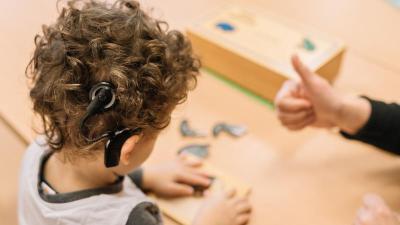Cochlear implants (CIs) represent a significant advancement in hearing technology. This article provides a comprehensive overview of cochlear implants: what they are, how they function, who they are suitable for, and the associated benefits and limitations.
What is a CI and How Does it Work?
A cochlear implant is a medical device designed to provide a sense of sound to individuals with significant hearing loss. Unlike hearing aids, which amplify sound, a cochlear implant transmits sound signals to the auditory nerves and the brain through electrical signals. Some people who are deaf or hard of hearing may be able to hear sounds again with a cochlear implant. Whether a cochlear implant can help you or your child depends on the degree and cause of the hearing loss.
The system consists of two primary components:
An external sound processor, worn behind the ear, which captures and processes sound from the environment.
An internal implant, which is surgically placed beneath the skin and into the cochlea, which receives signals from the processor and delivers them to the auditory nerve.
This technology enables the brain to interpret these signals as sound.

Who Can Benefit from a Cochlear Implant?
Cochlear implants are suitable for people who meet specific clinical criteria, such as:
Children with congenital (present at birth) or early-onset hearing loss
Adults with acquired hearing loss who no longer benefit from hearing aids
If a cochlear implant is suitable for you is typically determined through a comprehensive assessment by an audiologist and others in a CI team in a hospital. An assessment usually includes audiometric testing, speech perception evaluation, and medical imaging.
To choose for a cochlear implant or not is a very personal choice. Some people are very happy with it, while others consciously choose not to have one.
What To Expect From a Cochlear Implant?
It is important to understand that a cochlear implant does not restore natural hearing. Instead, it provides a new method of sound perception that can take time to adapt to.
"Many people are able to understand speech with a CI," explains audiologist Lisette Zwemmer. "This also depends on the age at which you receive the CI. I often see that a CI is successful for people whose hearing has gradually worsened and who have always used hearing aids. However, the sound is very different compared to hearing aids. For example, if the cochlea is absent or the auditory nerve has not developed, cochlear implantation is not possible. Also, if there is a significant amount of residual hearing, hearing aids are often the better option."
The CI Procedure: Step-by-Step
The process of receiving a cochlear implant involves several phases, each essential to ensuring a successful outcome:
1. Assessment and evaluation: A multidisciplinary team conducts detailed hearing assessments, imaging, and consultation to determine suitability. If you are suitable for a CI, you can still make your own decision about whether you want one.
2. Surgical implantation: You receive your cochlear implant in this procedure, which is performed under general anaesthesia and typically lasts one to two hours.
3. Post-operative healing: A healing period of approximately 2 to 4 weeks follows the surgery, during which the implant is monitored.
4. Device activation: Once you are healed, the external processor is fitted and activated, and the system is programmed to suit your hearing needs.
5. Rehabilitation: Ongoing sound training and speech therapy are used to help you with interpreting sounds. Each step requires collaboration with healthcare professionals.
Myths and Misconceptions About Cochlear Implants
There are several common misconceptions about cochlear implants that may influence decision-making:
Cochlear implants are only for children: In fact, adults of all ages, including older adults, can benefit from CIs.
Cochlear implants completely restore hearing: The implant does not replicate natural hearing but enables access to sound that would otherwise be inaccessible.
CIs are a better choice than hearing aids: Cochlear implants and hearing aids serve different purposes, and the best option depends on individual needs, hearing levels, and of course preference.
Recipients can no longer enjoy music: While music perception can be challenging at first, many users gradually develop the ability to enjoy music again, sometimes with training.

Professional Support and Rehabilitation
Whether a cochlear implant is successful in the long run depends on continued support from qualified professionals, including:
Audiologists, for programming and monitoring the device
Speech-language therapists, for language development and communication training
Educators and specially trained teachers, for school-aged children
Family support and peer networks, to provide encouragement and shared experiences
While it can be a long process, cochlear implants provide an effective solution for individuals with severe to profound hearing loss who do not benefit from hearing aids. The decision to proceed with a CI involves careful consideration, but the outcomes can be very successful for some individuals, providing them better access to sound and communication.
At Kentalis International Foundation, we are dedicated to bridging communication barriers. We focus on improving access and quality of education for learners with hearing loss. Learn more about our mission or make a donation to support children with hearing loss in the Global South.
Our parent organization, Royal Kentalis, offers diverse services for deaf and hard-of-hearing persons in the Netherlands. To learn more, visit their website at www.kentalis.nl (in Dutch).